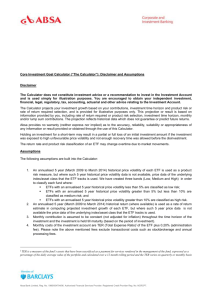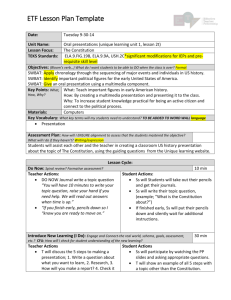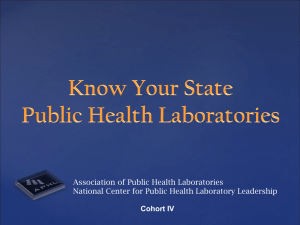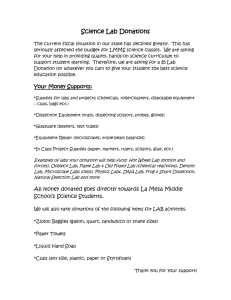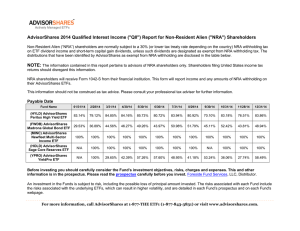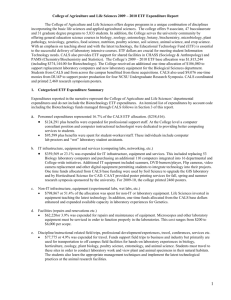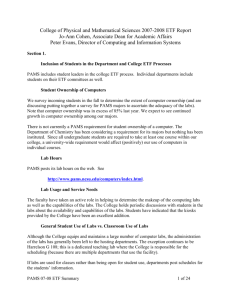End-of-Year ETF Report Fiscal Year 2008
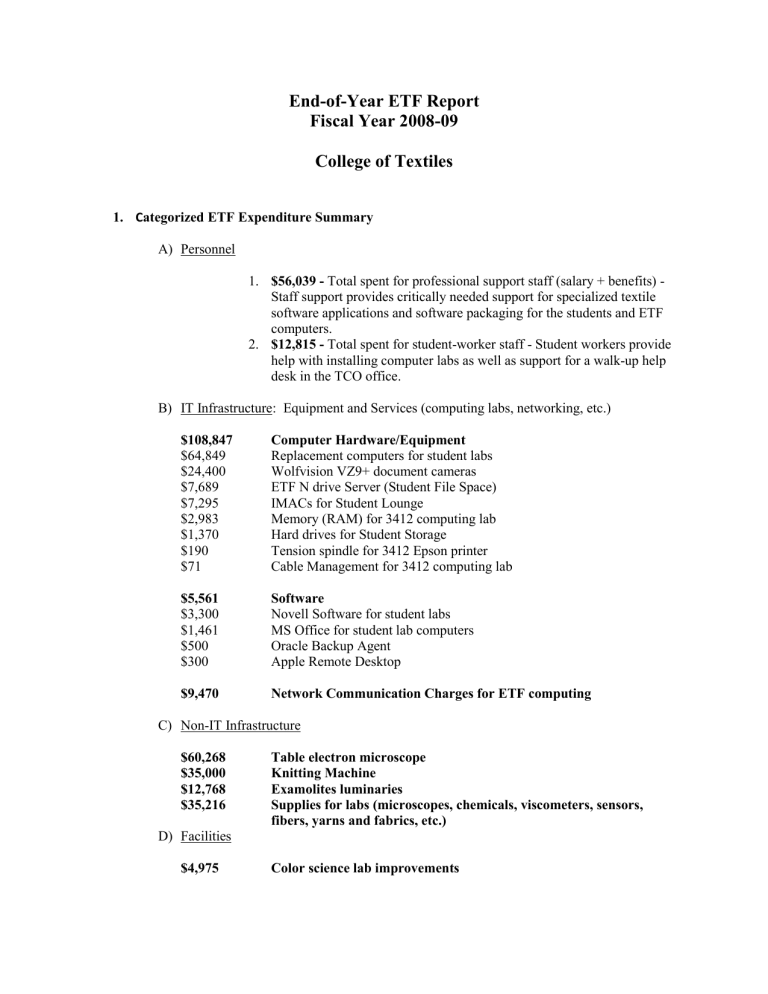
End-of-Year ETF Report
Fiscal Year 2008-09
College of Textiles
1.
C ategorized ETF Expenditure Summary
A) Personnel
1.
$56,039 - Total spent for professional support staff (salary + benefits) -
Staff support provides critically needed support for specialized textile software applications and software packaging for the students and ETF computers.
2.
$12,815 - Total spent for student-worker staff - Student workers provide help with installing computer labs as well as support for a walk-up help desk in the TCO office.
B) IT Infrastructure: Equipment and Services (computing labs, networking, etc.)
$108,847
$64,849
$24,400
$7,689
$7,295
$2,983
$1,370
Computer Hardware/Equipment
Replacement computers for student labs
Wolfvision VZ9+ document cameras
ETF N drive Server (Student File Space)
IMACs for Student Lounge
Memory (RAM) for 3412 computing lab
Hard drives for Student Storage
Tension spindle for 3412 Epson printer
Cable Management for 3412 computing lab
$190
$71
$5,561
$3,300
$1,461
$500
$300
Software
Novell Software for student labs
MS Office for student lab computers
Oracle Backup Agent
Apple Remote Desktop
$9,470 Network Communication Charges for ETF computing
C) Non-IT Infrastructure
$60,268
$35,000
$12,768
$35,216
Table electron microscope
Knitting Machine
Examolites luminaries
Supplies for labs (microscopes, chemicals, viscometers, sensors, fibers, yarns and fabrics, etc.)
D) Facilities
$4,975 Color science lab improvements
E) Discipline/Instructional: Field trips, professional development/experiences, travel, conferences, services, etc.
$3,500 Training for Package Development-Lectra
Lectra Software consulting service $1,000
$105 Mass Spec Services
2.
Justification/Purpose of Expenditures– Strategic Overview
A) New and/or Transformative Initiatives Undertaken with ETF
1.
The majority of ETF funding is used for supplies for various laboratories, replacement computers and software, as well as technical support staff.
2.
Table electron microscope – Almost every student that graduates through the
College of Textiles has some kind of experience involving inquiry into microscopic structures. Currently, we are using conventional optical microscopes to give students hands-on experience, but the optical microscope does not have adequate resolving power to image many unique structure features.
The FEI Phenom will give students hands-on experience in characterizing fiber structure both at micro and nano scales. It will help students better visualize knowledge learned from the class.
3.
Knitting Machine funds were matched from College resources. This new machine replaced older technology and was used in many undergraduate and graduate laboratory sections. Additionally, it found considerable use by students specializing in knitted fabric design, since it offers capabilities which were not previously available in the college.
4.
The luminaries and the accompanying modifications to the color science laboratory provide much improved resources for color science. While the facilities were designed for use by PCC majors, the laboratory and the luminaries will be used by all students in COT since color is a key feature of most textile products and an appreciation of the impact of different light sources on perceived color is of major importance.
5.
As indicated in previous reports, the software used by students in different majors is becoming more specialized. This not only impacts selection of appropriate hardware, but additionally requires considerable input from support staff. It has been found necessary to dedicate an IT specialist to be responsible for configuring machines to enable the use of recently acquired software and routine maintenance and set-up for laboratory/studio classes.
B) Actions taken to improve efficiency/return on ETF investments
1.
The College has excellent relationships with the industry and aims at negotiating significant discounts on most purchases. Additionally, the ETF funding is often matched, or supplemented, by financial support from other sources. The College
ETF Committee critically reviews proposed expenditure and mainly supports purchases which will benefit the maximum number of students.
2.
The server purchased this year will initially provide file space for the students’ coursework but will become backup storage as a newer cheaper system will be piloted in the 2009-2010 fiscal year.
3.
The Novell software cost was less this fiscal year and will be eliminated in the coming fiscal year with all labs being converted to the Wolftech AD domain which has no licensing costs.
C) Unmet ETF-eligible needs
As indicated last year, the changing enrollment pattern of students entering the College, particularly in their choice of major, will require more specialized computing resources and other equipment. The specific unmet needs of the Departments are:
1.
TATM Department a.
Materials for the Textile Management Science Laboratory: this is a newly established laboratory which will be potentially used by the majority of students in COT. Financial shortfalls during the reporting period precluded to the purchase of materials for this laboratory for student use. If monies existed, we would have purchased: i.
Data sources - print materials and data bases/sources that are used by students in the classes and which are not available via the library or online. ii.
Storage facilities for students to access materials/resources. iii.
Presentation materials/props/mannequins/display fabrics and backgrounds - for use in display of materials and products, several brand marketing classes, and in fashion classes. iv.
Technology for use in analysis and presentation of FTM classroom projects. v.
Miscellaneous supplies for student usage. b.
Lab supplies to be used by the large number of students in the labs to complete classroom assignments in the Digital Design Center; Fashion
Studios; Textile Design Studios; and other Departmental laboratories.
These unmet needs range from class supplies such as fabric, paper, dyes for printing etc. through to replacement electrical components to facilitate repair to necessary machines. c.
Resources to enable students to have greater exposure to global competitions. These include brand marketing, fashion, design, and new product development competitions, which not only form a key part of a student’s career development but also raise the profile and increase the prestige of our programs (and students).
2.
TECS Department a.
For PCC, we have an immediate need for properly calibrated light boxes.
We also need a new high quality ink-jet printer for PCC. b.
For Textile Engineering, the digital and analog electronics laboratory has aged considerably, and we have an immediate need for oscilloscopes and circuits laboratory kits. The cost is approximately $10,000.
c.
For Textile Technology, we have discussed the immediate need for a medical textiles laboratory for undergraduate instruction for many years.
Also for Textile Technology, we are reenergizing our commitment to a composites laboratory including manufacturing and testing facilities.
3.
College Laboratories a.
The college has several processing laboratories which house industrial scale machinery for the manufacture of various textile products. These laboratories are used in undergraduate and graduate classes and also find extensive use by students working on special projects or in capstone classes. The machinery in these laboratories is ageing and requires updating or replacing. As indicated in an earlier review (June, 08) it is estimated that this would require an additional $2 million.
4.
IT Infrastructure a.
The need for SPA full-time labor to maintain and support ETF computer labs at Textiles has continued to increase this fiscal year. The support level has increased to require a Tier 2 support person for software training and installation. This has created the need for a Tier 1 support person to address the routine daily needs of the students and instructor during classes.
3.
Assessment of impact of ETF investments on student learning
The College maintains a log of computer lab usage for our general purpose computing labs. The usage is recorded several times a day. Lab operators observe and report back if students are waiting to use the computer lab. In the textile software specialty labs the faculty members involved in those labs will give feedback as to the usage and needs.
Our major use of ETF funds is to support all of the hands-on activities in our laboratories. It is essential that these facilities should be up to date and at least representative of those found in industry/research labs. The ETF monies also provide the students with a general purpose computing labs and specialist labs, which closely relate to the student’s major. The specialty labs supported by the ETF monies provide the students with the software and applications that they will utilize in future careers. This ensures that our students are very marketable in the workplace, as proved by our placement percentages in excess of 90%. The above discussed labs could not exist without the ongoing support of ETF monies.
Feedback on the lab experience and access to modern technology can be gleaned from students’ reviews of classes and student and alumni surveys. In general the feedback is positive and this is largely due to judicious use of ETF (and other) support.
4.
Planning and review process
The College has an ETF committee that oversees the ETF expenditures. The committee consists of the 2 Department Heads, the Associate Dean of Academics, the Director of Information
Technology, the Director of Textiles Off-Campus Programs, a graduate student representative and an undergraduate representative. Input on needs is solicited from students, staff and faculty in the college and requests for funding are reviewed by the committee. The College continues to operate under a three year plan for ETF expenditures for IT related systems.
